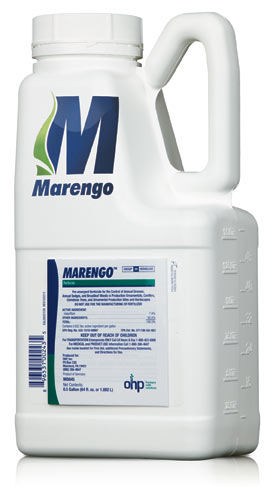OHP re-launches Terraclor® 400 ornamental fungicide
April 20, 2013
OHP, Inc. announces the re-launch of Terraclor® 400 Ornamental Fungicide for users in greenhouses, nurseries, and shadehouses.
In addition, Terraclor 400 may be used on landscape and field grown ornamentals.
The economical liquid fungicide is widely used for control of tough diseases such as rhizoctonia, sclerontinia, and phyllostica.
Terraclor 400 can be sprayed, drenched, or used as a bulb soak on a variety of woody plants, bedding plants, bulb crops such as gladiolas, hyacinths, iris, tulips, and lilies. Terraclor 400 can be used on Southern Magnolia Trees for control of phyllostica cookeri.
The product may also be used as a soil drench on vegetable bedding plants grown in containers or beds including tomatoes, peppers, broccoli, and cabbage for control of rhizoctonia solani prior to transplanting in the field.
Terraclor 400 carries a 12-hour REI and a Caution signal word.
State registrations are pending and for more information click here.
OHP Inc. is a leading marketer of pest solutions to the production ornamental industry.
Floramite® Miticide now offered in new 8 fl.oz. package
April 20, 2013
We are pleased to announce the immediate availability of Floramite® SC/LS Miticide in a new 8 fl. oz. package.
The new convenient packaging is ideal for the small landscaper or grower and offers a significant profit opportunity for distribution.
Floramite, the leading miticide in the ornamental market, offers fast and thorough control of many types of mites including two-spotted spider mites, spruce spider mites, and Lewis mites. It is extremely soft on beneficial and predatory insects.
We thank you for your support of the introduction of Floramite SC/LS in the 8 fl. oz. size. Please contact your local OHP Regional Sales Manager here for more information.
Prevention and Management of Boxwood Blight
January 28, 2013
by Kelly Ivors, Extension Plant Pathologist, Dept. of Plant Pathology, NC State University
This disease can significantly impact the appearance and aesthetics of boxwood because the foliage typically becomes blighted and drops from the plant. Symptoms of box blight include: dark‐ or light‐brown, circular leaf spots often with darker margins; dark stem cankers or black ‘streaks’ on stems; straw‐ to bronze‐ colored, blighted foliage; and leaf drop. Leaf spots may grow together to eventually cover the entire leaf (see pictures). In container boxwood, sometimes only the lower foliage and stems become infected, leaving the tops green and making the plant appear top‐heavy.On large field‐grown or landscape plants only one section of the plant closest to the ground on the shaded side will be blighted.
…full article found here.
Photos of Boxwood Blight found here.
OHP launches new Marengo® herbicide
December 18, 2012
OHP Inc. is proud to announce the introduction of Marengo® Herbicide to growers in the production ornamental market. Marengo has received its federal EPA registration and is undergoing the state registration process.
Marengo has received its federal EPA registration and is undergoing the state registration process.
Marengo, with the exciting new active ingredient indaziflam, is a selective pre-emergent herbicide that offers long-term residual control of both grassy and broadleaf leaves.
“We are thrilled to add Marengo to our expanding herbicide portfolio,” notes Dan Stahl, OHP vice president of marketing and business development. “Marengo offers unparalleled residual control of many hard-to-control weeds with impressive plant safety.”
Marengo contains the first active ingredient from MOA (Mode of Action) Group 29. The active ingredient prevents weed seed germination by inhibiting cellulose biosynthesis. Marengo does not move once applied to the soil and does not volatilize.
Marengo is registered for use on production ornamentals grown in outdoor nurseries, as well as on conifers, Christmas trees, and ornamental production sites and hardscapes. Marengo is labeled for use in shade houses and hoop houses as well.
“Marengo offers extended broad-spectrum weed control of up to eight months in nurseries but also in extended use sites such as hardscapes and hoop houses,” notes Dave Barcel, OHP senior technical manager. “It’s extremely active at low use rates.”
Marengo use rates range from 7.5 to 18.5 fl.oz. per acre depending on soil type and conditions. It performs best when applied to bare ground or mixed with a post-emergent herbicide to eliminate existing weeds.
Marengo should be applied as a broadcast spray over ground areas and as a directed spray for field grown ornamentals. Fall applications have shown excellent weed control through the following spring season.
Marengo will be packaged in one-half gallons, packed 4 to a case.
For information on current state registrations, click here.
OHP is a leading marketer of pest and weed control solutions to the production ornamentals market.
(Marengo is a registered trademark of Bayer.)
OHP adds Dr. Carlos Bogràn to tech team
October 31, 2012
OHP Inc. announces the addition of Dr. Carlos Bográn to its team of horticulture professionals.
Bográn assumes the role of OHP Technical Manager with focus on fungicide and insecticide support and development.
He joins OHP after 11 years as assistant and then associate professor and extension specialist in the departments of entomology and plant pathology, and microbiology at Texas A&M’s AgriLife Extension Service in Bryan, TX. In that role, Bográn conducted applied research and directed state-wide education programs.
“We are thrilled to add Carlos to the OHP family,” notes Dan Stahl, OHP VP of marketing and business development.
“He brings unique skills to our company with his breadth of knowledge on insecticides and fungicides,” notes Stahl. “Plus he is fluent in Spanish which is critical in today’s world of horticulture.”
Bográn holds a doctorate degree in entomology from Texas A&M University and a master’s degree in entomology from Iowa State University.
In his 18 years in agricultural research and extension, Bográn has authored close to 100 articles in industry and scientific journals and extension publications.
He will assume some of the duties of OHP Director of Technical Services Jeff Dobbs, who is retiring effective Dec. 31, 2012.
“Jeff’s contributions to OHP are far-reaching,” notes Stahl. “We wish him all the best in his retirement.”
David Barcel, OHP senior technical manager, will work in tandem with Bográn and continue to focus his efforts on herbicides and plant growth regulator (PGR) research and development.
OHP is a leading marketer of pest control solutions to the nursery, greenhouse and associated markets.